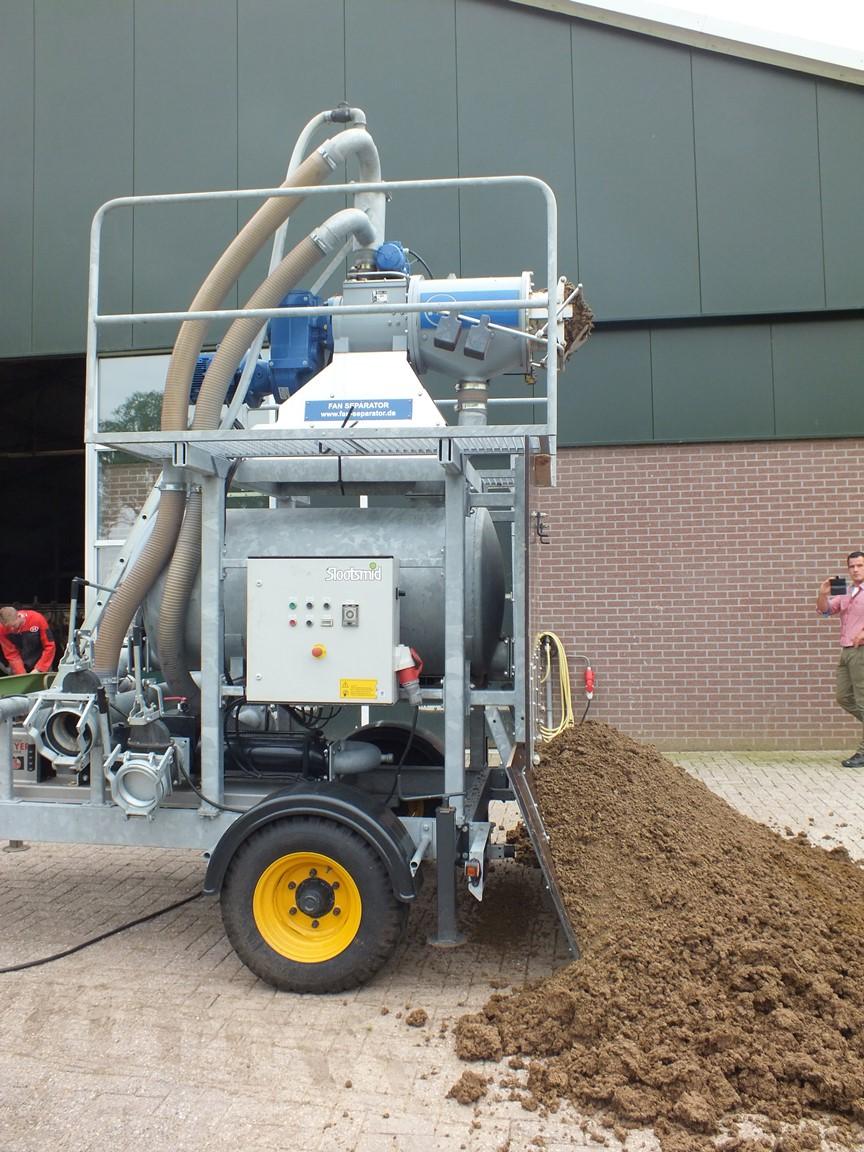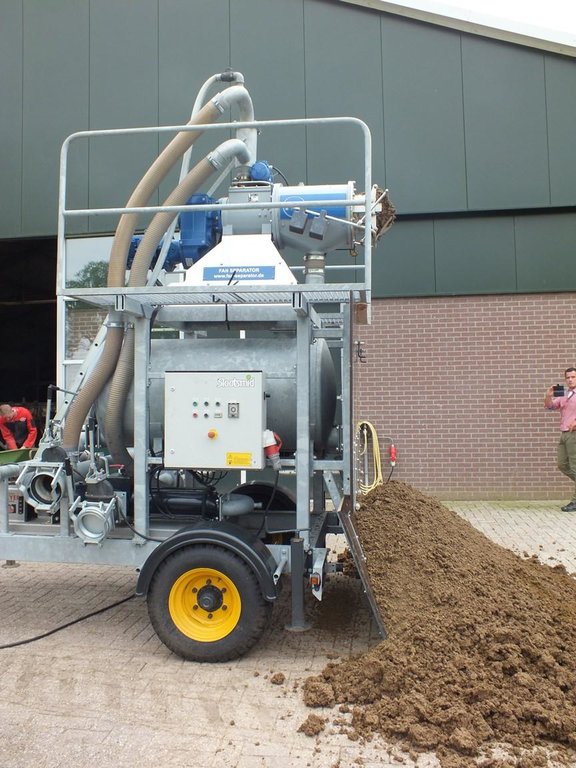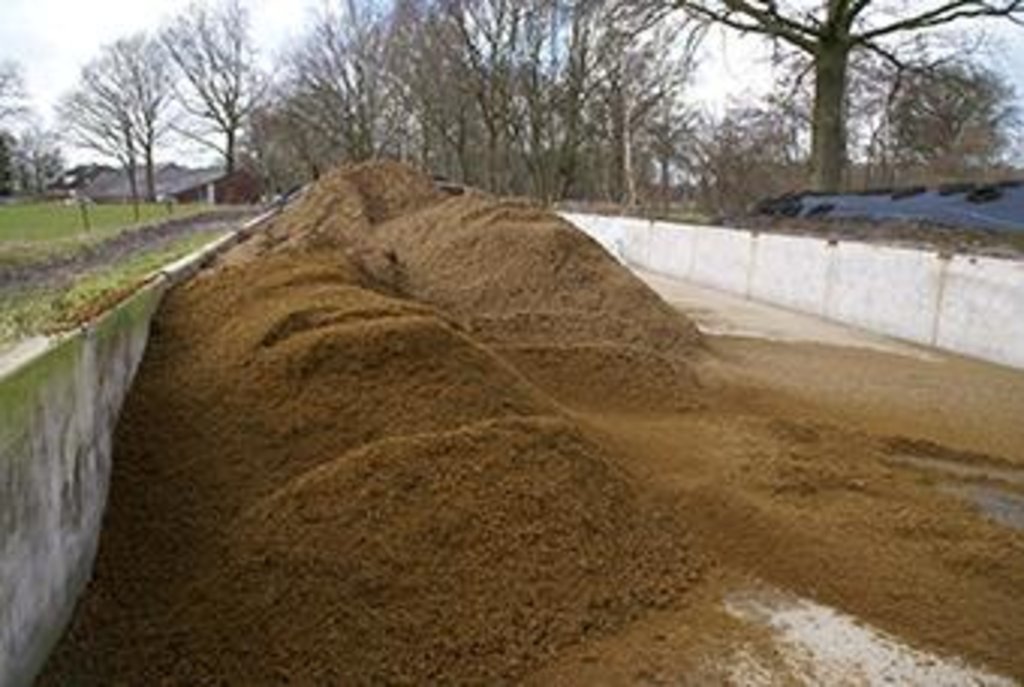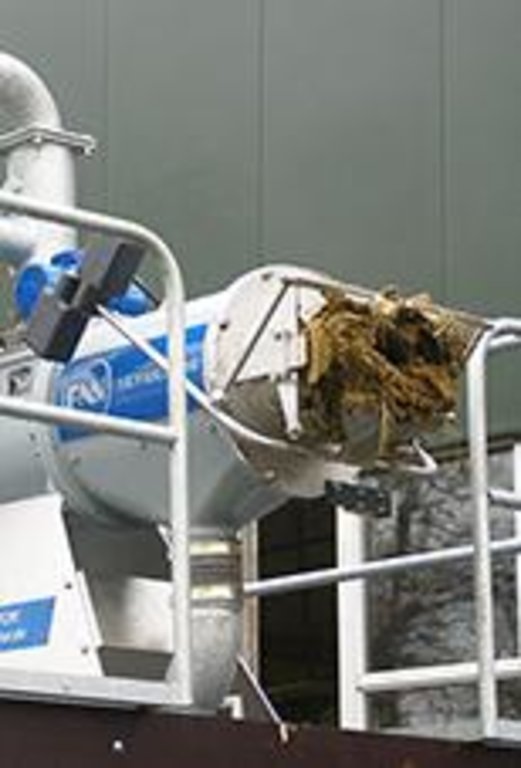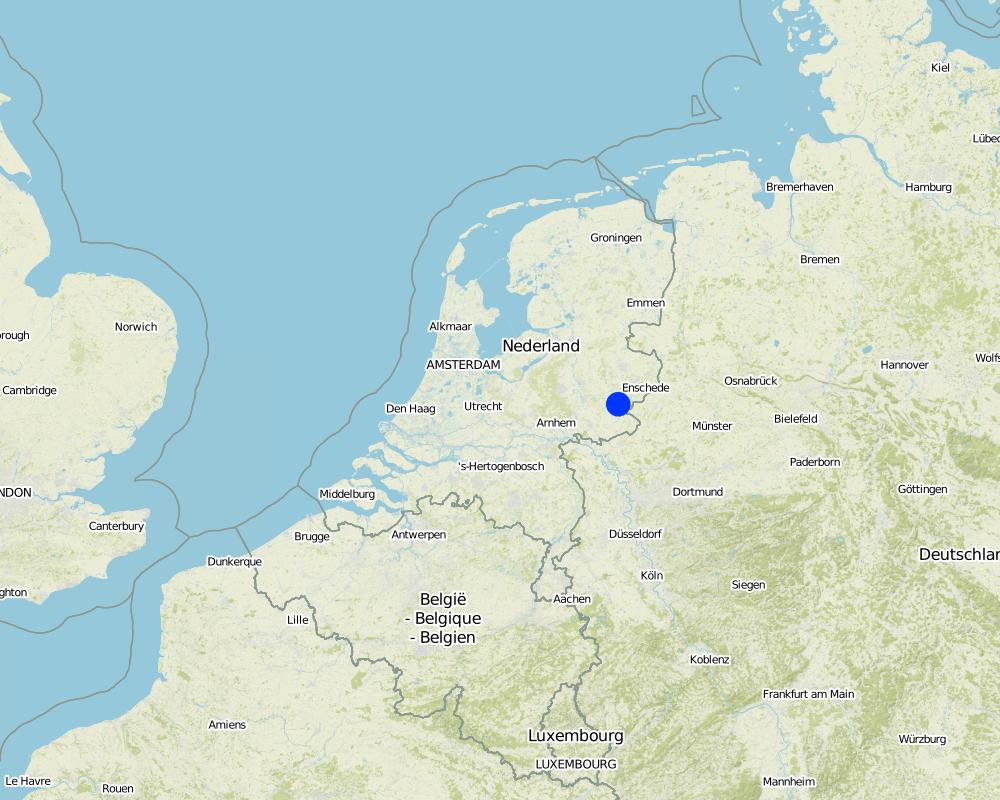Manure separation to better distribute organic matter at farm level [Pays-Bas]
- Création :
- Mise à jour :
- Compilateur : Simone Verzandvoort
- Rédacteur : –
- Examinateurs : Fabian Ottiger, Alexandra Gavilano
Mestscheiding om organische stof op bedrijfsniveau beter te verdelen (NL)
technologies_1256 - Pays-Bas
Voir les sections
Développer tout Réduire tout1. Informations générales
1.2 Coordonnées des personnes-ressources et des institutions impliquées dans l'évaluation et la documentation de la Technologie
Spécialiste GDT:
Smit Annemieke
Wageningen Environmental Research (Alterra)
Pays-Bas
Spécialiste GDT:
Leever Henk
HOEDuurzaam
Pays-Bas
Spécialiste GDT:
Rienks Willem
Rom3D
Pays-Bas
Nom du projet qui a facilité la documentation/ l'évaluation de la Technologie (si pertinent)
Preventing and Remediating degradation of soils in Europe through Land Care (EU-RECARE )Nom du ou des institutions qui ont facilité la documentation/ l'évaluation de la Technologie (si pertinent)
Hoe Duurzaam - Pays-BasNom du ou des institutions qui ont facilité la documentation/ l'évaluation de la Technologie (si pertinent)
ROM3D - Pays-BasNom du ou des institutions qui ont facilité la documentation/ l'évaluation de la Technologie (si pertinent)
Wageningen Environmental Research (Alterra) - Pays-BasNom du ou des institutions qui ont facilité la documentation/ l'évaluation de la Technologie (si pertinent)
Provincie Gelderland - Pays-BasNom du ou des institutions qui ont facilité la documentation/ l'évaluation de la Technologie (si pertinent)
Vitens - Laat Water Voor Je Werken - Pays-Bas1.3 Conditions relatives à l'utilisation par WOCAT des données documentées
Le compilateur et la(les) personne(s) ressource(s) acceptent les conditions relatives à l'utilisation par WOCAT des données documentées:
Oui
2. Description de la Technologie de GDT
2.1 Courte description de la Technologie
Définition de la Technologie:
Separation of cow manure is a common practice on dairy farms in The Netherlands to improve the nutrient use efficiency.
2.2 Description détaillée de la Technologie
Description:
Het primaire doel van mestscheiding is de productie van een dikke
fractie met hoge gehalten aan organische stof en mineralen en een laag vochtgehalte. Een dergelijke geconcentreerde
fosfaatrijke fractie is een waardevolle organische meststof en kan over grote afstand vervoerd worden. De
dunne waterige fractie, met daarin het grootste deel van de stikstof, kan op eigen grond of in de nabije omgeving als
meststof worden aangewend of verder worden gezuiverd tot loosbaar water.
Slurry manure is fed through a manure separator that separates much of the thick material from the liquid portion. These fractions differ in the proportion between P and N; the thick fraction contains relatively more P than the thin fraction.
The thick fraction is used on maize fields or as substrate in cow stables; the thin fraction, with the larger part of the nitrogen, can be used on other parts of the farm or is exported from the farm to be treated for discharge in the environment. Due to stricter regulations for the application of N and P to crop land and grassland, less manure may be applied to the land. If manure must be exported because the threshold for P is reached, this implies that also N is exported from the farm.
Purpose of the Technology: Slurry from livestock consists of more than 90% of water. The primary purpose of manure separation is to produce a thick fraction with high contents of organic matter and nutrients and a low moisture content. The thick fraction is a valuable fertiliser and can be transported over large distances. The thin fraction, with the larger part of the nitrogen, can be applied as fertiliser on the farm, on farmland in the proximity, or can be treated into a quality suitable for discharge in the environment or water drainage system.
Manure separation allows farmers to use organic matter from manure more efficiently at the farm level. Manure separation increases the efficiency of processing and using manure in 5 ways:
1. By concentrating phosphorus in the thick fraction the volume of manure to be exported can be decreased, and also the export of nitrogen from the farm.
2. Manure separation creates three types of manure (thick, thin and mixed), which allows for differentiated application to different fields and crops, and reductions on requirements for artificial fertiliser.
3. Manure separation decreases the volume of manure to be exported from farms, and therefore saves energy and transport costs.
4. The thick fraction can be stored in stacks, taking up less space.
5. The thick fraction can be used as substrate in stables, replacing costly sawdust.
Establishment / maintenance activities and inputs: Purchase a manure separator. Periodically feed your collected slurry manure through the separator and then apply the thick portion to your fields. Discard the liquid portion.
Natural / human environment: Dairy farming on sandy soils in the eastern part of The Netherlands. Stricter manure regulation originting from the Nitrates Directive sets a limit on the amounts of animal manure for farms on sandy and loess soils in the eastern and southern part of The Netherlands.
2.3 Photos de la Technologie
2.5 Pays/ région/ lieux où la Technologie a été appliquée et qui sont couverts par cette évaluation
Pays:
Pays-Bas
Région/ Etat/ Province:
Gelderland
Autres spécifications du lieu:
Haarlo - Oude Eibergen
Spécifiez la diffusion de la Technologie:
- répartie uniformément sur une zone
S'il n'existe pas d'informations exactes sur la superficie, indiquez les limites approximatives de la zone couverte:
- < 0,1 km2 (10 ha)
Commentaires:
The thick manure fraction is applied to corn fields. There is 240 ha of corn in the area amongst 44 farmers. Only 2 farmers are applying this technology.
Map
×2.6 Date de mise en œuvre de la Technologie
Si l'année précise est inconnue, indiquez la date approximative: :
- il y a moins de 10 ans (récemment)
2.7 Introduction de la Technologie
Spécifiez comment la Technologie a été introduite: :
- par le biais de projets/ d'interventions extérieures
Commentaires (type de projet, etc.) :
The land users's initiative was through the application for the project Healthy Sand by a group of farmers. During the Gezond Zand Project the group organised themselves in the Foundation HOEDuurzaam. The project ran from 2012-2014 and is followed by the new project BodemRijk.
The external initiative was from the drinking water company Vitens and the Province of Gelderland in the same period.
3. Classification de la Technologie de GDT
3.2 Type(s) actuel(s) d'utilisation des terres, là où la Technologie est appliquée

Terres cultivées
- Cultures annuelles
Cultures annuelles - Précisez les cultures:
- céréales - maïs
- céréales - autres
- cultures fourragères - graminées
- plantes à racines et à tubercules - pommes de terre
Nombre de période de croissance par an: :
- 1
Précisez:
Longest growing period in days: 250Longest growing period from month to month: March-November

Pâturages
Pâturage intensif/ production fourragère :
- Affouragement en vert/ zéro-pâturage
- Prairies améliorées
Commentaires:
Major cash crop annual cropping: Potatoes
Major food crop annual cropping: Maize, cereals
Major food crop perennial (non-woody) cropping: Grass
Major land use problems (compiler’s opinion): Decrease of soil organic matter content.
Major land use problems (land users’ perception): The group of farmers in the area expeience decreasing organic matter content in soil.
Cut-and-carry/ zero grazing: feeding in stables
Improved pasture: feeding in field
Livestock density: > 100 LU /km2
3.4 Approvisionnement en eau
Commentaires:
Water supply: rainfed, mixed rainfed - irrigated, rainfed, mixed rainfed - irrigated
3.5 Groupe de GDT auquel appartient la Technologie
- gestion intégrée de la fertilité des sols
3.6 Mesures de GDT constituant la Technologie

pratiques agronomiques
- A2: Matière organique/ fertilité du sol
Commentaires:
Main measures: agronomic measures
Type of agronomic measures: manure / compost / residues
3.7 Principaux types de dégradation des terres traités par la Technologie

dégradation chimique des sols
- Cn: baisse de la fertilité des sols et réduction du niveau de matière organique (non causée par l’érosion)
Commentaires:
Main type of degradation addressed: Cn: fertility decline and reduced organic matter content
Main causes of degradation: soil management (Intensive ploughing)
Secondary causes of degradation: crop management (annual, perennial, tree/shrub) (Intensive crop management)
3.8 Prévention, réduction de la dégradation ou réhabilitation des terres dégradées
Spécifiez l'objectif de la Technologie au regard de la dégradation des terres:
- restaurer/ réhabiliter des terres sévèrement dégradées
Commentaires:
Main goals: rehabilitation / reclamation of denuded land
4. Spécifications techniques, activités, intrants et coûts de mise en œuvre
4.1 Dessin technique de la Technologie
Spécifications techniques (associées au dessin technique):
Slurry manure is the influent placed into the separator. A drill-press pushes the slurry and pressure squeezes out the liquid portion (Liqour). The thick manure (cake) is pressed out the end. The screen holds the solid material in the drill press.
Location: not applicable. not applicable
Date: 13-01-2008
Technical knowledge required for field staff / advisors: moderate (The agricultural advisor should advise on options for application of the thick fraction of manure based on composition.)
Technical knowledge required for land users: moderate (Farmer has to calculate and strategize distribution of thick manure fractions and RDM(slurry) to reach balanced application rates and consider impact between fields.)
Technical knowledge required for technical advisor from machine company: moderate (Technical advisor should advise on type of manure separator (screw or roller) depending on the intended use of the thick and thin fractions.)
Main technical functions: increase in organic matter
Secondary technical functions: increase in nutrient availability (supply, recycling,…)
Manure / compost / residues
Material/ species: Thick fraction obtained by separation of manure from dairy cows.
Quantity/ density: 10 t/ha
Remarks: The thick fraction is applied separately from the slurry.
Auteur:
Extension, http://www.extension.org/pages/27470/solids-separation-in-swine-manure-handling-systems#.VU9uDk0cRoI
4.2 Informations générales sur le calcul des intrants et des coûts
autre/ monnaie nationale (précisez):
Euro
Indiquez le taux de change des USD en devise locale, le cas échéant (p.ex. 1 USD = 79.9 réal brésilien): 1 USD = :
0,94
Indiquez le coût salarial moyen de la main d'œuvre par jour:
255.70
4.3 Activités de mise en place/ d'établissement
| Activité | Calendrier des activités (saisonnier) | |
|---|---|---|
| 1. | Buy a seperator |
4.4 Coûts et intrants nécessaires à la mise en place
| Spécifiez les intrants | Unité | Quantité | Coûts par unité | Coût total par intrant | % des coût supporté par les exploitants des terres | |
|---|---|---|---|---|---|---|
| Equipements | Seperator | Machine | 1,0 | 5320,0 | 5320,0 | |
| Coût total de mise en place de la Technologie | 5320,0 | |||||
| Coût total de mise en place de la Technologie en dollars américains (USD) | 5659,57 | |||||
Commentaires:
Life span of the seperator: 6 years
Number of parties sharing: 44
4.5 Activités d'entretien/ récurrentes
| Activité | Calendrier/ fréquence | |
|---|---|---|
| 1. | Operating separator | once per year |
| 2. | Applying both thick fraction manure and RDM manure | once per year |
4.6 Coûts et intrants nécessaires aux activités d'entretien/ récurrentes (par an)
| Spécifiez les intrants | Unité | Quantité | Coûts par unité | Coût total par intrant | % des coût supporté par les exploitants des terres | |
|---|---|---|---|---|---|---|
| Main d'œuvre | Labour | ha | 1,0 | 127,68 | 127,68 | 100,0 |
| Main d'œuvre | Sampling manure | ha | 1,0 | 21,28 | 21,28 | 100,0 |
| Equipements | Machine use | ha | 1,0 | 308,56 | 308,56 | 100,0 |
| Equipements | rent of manure separator | h | 1,0 | 16,5 | 16,5 | 100,0 |
| Equipements | depreciation costs | m3 | 1,0 | 0,65 | 0,65 | |
| Equipements | maintenance | machine | 1,0 | 0,3 | 0,3 | |
| Equipements | Electricity | ha | 1,0 | 3,72 | 3,72 | 100,0 |
| Engrais et biocides | Extra Potassium | ha | 1,0 | 10,64 | 10,64 | 100,0 |
| Coût total d'entretien de la Technologie | 489,33 | |||||
| Coût total d'entretien de la Technologie en dollars américains (USD) | 520,56 | |||||
Commentaires:
Machinery/ tools: Separator, truck, loader, tractor
Cost of everything per hour was multiplied by totals and divided by hectares applied so costs per hectare are given. The establishment cost of the separator is the total unit. It was purchased by the farmer's foundation. It can not be given in a cost per hectare.
4.7 Facteurs les plus importants affectant les coûts
Décrivez les facteurs les plus importants affectant les coûts :
Labour. Equipment.
5. Environnement naturel et humain
5.1 Climat
Précipitations annuelles
- < 250 mm
- 251-500 mm
- 501-750 mm
- 751-1000 mm
- 1001-1500 mm
- 1501-2000 mm
- 2001-3000 mm
- 3001-4000 mm
- > 4000 mm
Spécifications/ commentaires sur les précipitations:
182 days of precipitation annually
Zone agro-climatique
- subhumide
Thermal climate class: temperate. Mean monthly temperature varies between 2-17 °C ( LGP 240-269 days, mean monthly temperature varies between 2-17 °C)
5.2 Topographie
Pentes moyennes:
- plat (0-2 %)
- faible (3-5%)
- modéré (6-10%)
- onduleux (11-15%)
- vallonné (16-30%)
- raide (31-60%)
- très raide (>60%)
Reliefs:
- plateaux/ plaines
- crêtes
- flancs/ pentes de montagne
- flancs/ pentes de colline
- piémonts/ glacis (bas de pente)
- fonds de vallée/bas-fonds
Zones altitudinales:
- 0-100 m
- 101-500 m
- 501-1000 m
- 1001-1500 m
- 1501-2000 m
- 2001-2500 m
- 2501-3000 m
- 3001-4000 m
- > 4000 m
Commentaires et précisions supplémentaires sur la topographie:
Altitudinal zone: 0-100 m a.s.l. (up to 45 metres a.s.l.)
Slopes on average: Flat and gentle (only incidentally.)
5.3 Sols
Profondeur moyenne du sol:
- très superficiel (0-20 cm)
- superficiel (21-50 cm)
- modérément profond (51-80 cm)
- profond (81-120 cm)
- très profond (>120 cm)
Texture du sol (de la couche arable):
- grossier/ léger (sablonneux)
- moyen (limoneux)
Matière organique de la couche arable:
- abondant (>3%)
- moyen (1-3%)
Si disponible, joignez une description complète du sol ou précisez les informations disponibles, par ex., type de sol, pH/ acidité du sol, capacité d'échange cationique, azote, salinité, etc.
Soil depth on average: Deep (A and B horizons up till 40 cm in Gleyic Podzols and Umbric Gleysols (ca 75% of the area). Hardly any soil organic matter below 15 cm. Rooting depth is up to 80 cm.) and very deep (deep topsoils rich in organic matter in the Fimic Anthrosols (12% of the area).)
Soil texture is coarse/light (most soils have a sandy texture due to the substrate consisting of cover sands) and medium (Soils in former creek valleys contain loam (Umbric Gleysols))
Soil fertility is low (Most soils have a low fertility due to the sandy substrate (specifically the Gleyic Podzols, ca 40% of the area)) and very high (in Fimic Anthrosols originated due to application of farmyard manure since medieval times (12% of the area))
Topsoil organic matter is medium (the purpose of the technology is to increase soil organic matter at farm level)
Soil drainage/infiltration is good (deep groundwater table (H>40-80 cm; L>120 cm) in the sandy soils on thick substrate of cover sands (in 65% of the area)) and medium (shallow groundwater tables in the Umbric Gleysols (35% of the area).
Soil water storage capacity is medium (in the other soils, varying with the soil organic matter content) and very high (in the Fimic Anthrosols with high SOM in the topsoil.)
5.4 Disponibilité et qualité de l'eau
Profondeur estimée de l’eau dans le sol:
< 5 m
Disponibilité de l’eau de surface:
moyenne
Qualité de l’eau (non traitée):
faiblement potable (traitement nécessaire)
Commentaires et précisions supplémentaires sur la qualité et la quantité d'eau:
Ground water table: <5m (in all soil types the highest level of the groundwater table during the year is <140 cm below the soil surface. The lowest level can be lower than 120 cm)
Availability of surface water is medium (From small rivers (De Berkel) and creeks)
Water quality (untreated) is poor drinking water (levels of the pesticides Bentazon and MCPP in the groundwater have incidentally exceeded the norms for drinking water production between 1985 and 2009)
5.5 Biodiversité
Diversité des espèces:
- moyenne
Commentaires et précisions supplémentaires sur la biodiversité:
Soil biodiversity is high in the Fimic Anthrolsols.
5.6 Caractéristiques des exploitants des terres appliquant la Technologie
Orientation du système de production:
- exploitation mixte (de subsistance/ commerciale)
- commercial/ de marché
Revenus hors exploitation:
- moins de 10% de tous les revenus
Niveau relatif de richesse:
- moyen
Individus ou groupes:
- individu/ ménage
Niveau de mécanisation:
- mécanisé/ motorisé
Genre:
- hommes
Indiquez toute autre caractéristique pertinente des exploitants des terres:
Land users applying the Technology are mainly common / average land users
Difference in the involvement of women and men: Most outdoor farm operations are completed by men. Women often have jobs outside the farm.
Population density: 10-50 persons/km2
Annual population growth: < 0.5%
100% of the land users are average wealthy and own 100% of the land.
Off-farm income specification: Some farmers are contractual workers. Wives of farmers often have a job, e.g. at the municipality or craft work. Farms do not provide B&B or educational services.
Market orientation of cropland production system is mixed ( Maize is completely used to feed cows (max 20% of the area is allowd under maize); other arable crops are sold to the market. Dairy production is commercial. )
Market orientation of grazing land production system is commercial/market (dairy farmers grow feed crops for their livestock)
5.7 Superficie moyenne des terres utilisées par les exploitants des terres appliquant la Technologie
- < 0,5 ha
- 0,5-1 ha
- 1-2 ha
- 2-5 ha
- 5-15 ha
- 15-50 ha
- 50-100 ha
- 100-500 ha
- 500-1 000 ha
- 1 000-10 000 ha
- > 10 000 ha
Cette superficie est-elle considérée comme de petite, moyenne ou grande dimension (en se référant au contexte local)?
- moyenne dimension
Commentaires:
Average area of land owned or leased by land users applying the Technology: 5-15 ha, 15-50 ha, 50-100 ha
Cropland per household: 15-50 ha (6 land owners (situation in 2014)) and 50-100 ha (15 land owners, situation in 2014)
Grazing land per household: 5-15 ha (average grassland is 7.8 ha per household)
5.8 Propriété foncière, droits d’utilisation des terres et de l'eau
Propriété foncière:
- individu, avec titre de propriété
- Other forms of exploitation
Droits d’utilisation des terres:
- loué
- individuel
Commentaires:
Many fields have other forms of exploitation than individual ownership or lease.
5.9 Accès aux services et aux infrastructures
santé:
- pauvre
- modéré
- bonne
éducation:
- pauvre
- modéré
- bonne
assistance technique:
- pauvre
- modéré
- bonne
emploi (par ex. hors exploitation):
- pauvre
- modéré
- bonne
marchés:
- pauvre
- modéré
- bonne
énergie:
- pauvre
- modéré
- bonne
routes et transports:
- pauvre
- modéré
- bonne
eau potable et assainissement:
- pauvre
- modéré
- bonne
services financiers:
- pauvre
- modéré
- bonne
6. Impacts et conclusions
6.1 Impacts sur site que la Technologie a montrés
Impacts socio-économiques
Production
production agricole
Commentaires/ spécifiez:
expected, based on better targeted fertiliser application
Disponibilité et qualité de l'eau
demande pour l'eau d'irrigation
Commentaires/ spécifiez:
expected due to increase of SOM
Revenus et coûts
dépenses pour les intrants agricoles
Commentaires/ spécifiez:
On artificial fertiliser (30-80% reduction on N fertiliser) and substrate for cow stables. But since the thick fraction contains less N per kg of P2O5 than the original mix, farners applying the thick fraction (for maize as described in this QT) may need to apply more articial N-fertilizer
revenus agricoles
Commentaires/ spécifiez:
Decreased costs for manure export from the farm: A smaller part of the total manure mix needs to be exported (ca 35% less N-export than without manure separation; 10-30% less net energy use)
Autres impacts socio-économiques
Ease of manure storage
Commentaires/ spécifiez:
Thick fraction is less voluminous and can be stacked
Manure processing
Commentaires/ spécifiez:
Thick fraction can be more easily stored and transported; thin fraction takes up less volume and does not need to be transported.
Energy use
Quantité avant la GDT:
4-7 GJ/ha
Quantité après la GDT:
3-5 GJ/ha
Commentaires/ spécifiez:
Energy use for manure transport, processing, digestion and fertiliser use
Expenses on machinery
Commentaires/ spécifiez:
For farms with less than 1000-2000 tons of manure to be separated expenses on manure separation become larger than benefits. Such farms could better hire a mobile separator, as in the descirption of this SLM technology.
Impacts socioculturels
Improved livelihoods and human well-being
Commentaires/ spécifiez:
Dairy farmers have learned more about the importance of soil organic matter for their production systems, and about the consequences of soil and manure management on soil organic matter and other aspects of soil health. This learning was brought by the exchange of knowledge between farmers and experts, and between farmers themselves. Farmers also profited from services provided to them by the farmers' foundations: shared investments (e.g. in the manure separator) and support in the application for subsidies to finance the SLM measure.
Impacts écologiques
Cycle de l'eau/ ruissellement
qualité de l'eau
Commentaires/ spécifiez:
expected: reduction in leaching of nitrate and phosphorus due to better targeted manuring to plant needs
Sols
humidité du sol
Commentaires/ spécifiez:
due to increased SOM
matière organique du sol/ au dessous du sol C
Commentaires/ spécifiez:
due to improved manure composition for crop growth and build-up of SOM
Réduction des risques de catastrophe et des risques climatiques
émissions de carbone et de gaz à effet de serre
Commentaires/ spécifiez:
due to better targeted fertiliser use to needs of crops and reduced use of artificial fertiliser (30-80% less supply of N-fertiliser required)
Autres impacts écologiques
Emission of NH3
Quantité avant la GDT:
18
Quantité après la GDT:
20
Commentaires/ spécifiez:
NH3 loss in kg/ha, for dairy farms with 1.75 cows/ha, manure prod of 255 kg N/haand other assumptions; model estimate
P2O5 surplus
Quantité avant la GDT:
1
Quantité après la GDT:
4
Commentaires/ spécifiez:
P2O5 surplus in kg/ha, same conditions
6.2 Impacts hors site que la Technologie a montrés
pollution des rivières/ nappes phréatiques
Quantité avant la GDT:
12.5
Quantité après la GDT:
10.4
Commentaires/ spécifiez:
Reduced leaching of nitrate from fields where manure is applied due to less surplus of N in thin fraction(NO3-N in groundwater in mg/lfor farm with 1.75 dairy cows/ha)
Energy use
Quantité avant la GDT:
4-7 GJ/ha
Quantité après la GDT:
3-5 GJ/ha
Commentaires/ spécifiez:
Energy use for transport of manure from farms, processing, digestion, fertiliser use
6.3 Exposition et sensibilité de la Technologie aux changements progressifs et aux évènements extrêmes/catastrophes liés au climat (telles que perçues par les exploitants des terres)
Changements climatiques progressifs
Changements climatiques progressifs
| Saison | Augmentation ou diminution | Comment la Technologie fait-elle face à cela? | |
|---|---|---|---|
| températures annuelles | augmente | bien |
Extrêmes climatiques (catastrophes)
Catastrophes météorologiques
| Comment la Technologie fait-elle face à cela? | |
|---|---|
| pluie torrentielle locale | bien |
| tempête de vent locale | bien |
Catastrophes climatiques
| Comment la Technologie fait-elle face à cela? | |
|---|---|
| sécheresse | bien |
Catastrophes hydrologiques
| Comment la Technologie fait-elle face à cela? | |
|---|---|
| inondation générale (rivière) | bien |
Autres conséquences liées au climat
Autres conséquences liées au climat
| Comment la Technologie fait-elle face à cela? | |
|---|---|
| réduction de la période de croissance | bien |
Commentaires:
The technology is almost independent on environmental change, since it depends on the availability of manure. It is strongly dependent on the farming system (supply of manure and possibility to apply the separated fractions on farm).
6.4 Analyse coûts-bénéfices
Commentaires:
There is no evidence yet on economic and agronomic effects of using the manure separator in the area, so the land user's perspective cannot be given. Assessments of costs, effects and energy use based on modelling are available in the literature for dairy and arable farming in the NL in Schroder et al. (2009). These reveal that for farms with 1.75 to 2.18 dairy cows/ha and under conditions of manure production and application and manure regulations for this part of The Netherlands, the required export of N-manure could decrease by 35%, required N-fertiliser by 30-80%, and net energy use by 10-30%.
6.5 Adoption de la Technologie
Si disponible, quantifiez (nombre de ménages et/ou superficie couverte):
2
Commentaires:
100% of land user families have adopted the Technology with external material support
2 land user families have adopted the Technology with external material support
Comments on acceptance with external material support: The Foundation HOEDuurzaam purchased the manure separator. Farmers can use the machine for 15 euros/hour, and can apply for a subsidy from the Province when applying the technology. Two farmers were actively using the machine in 2014.
Comments on adoption trend: We do not have information on how many farmers were using the manure separator in 2015. This information will become available in 2016.
6.7 Points forts/ avantages/ possibilités de la Technologie
| Points forts/ avantages/ possibilités du point de vue de l'exploitant des terres |
|---|
|
increases soil organic matter How can they be sustained / enhanced? continued application of the measure and subsidy for maintenance of the manure separator by the Foundation; support to farmers in calculating parameters for manure separation specific for their farm (type of manure, concentrations, fields to apply to, livestock intensity) |
| energy saving and reduced loss of N while maintaining equal levels of crop production |
| Points forts/ avantages/ possibilités du point de vue du compilateur ou d'une autre personne ressource clé |
|---|
|
increases soil organic matter How can they be sustained / enhanced? continued application of the measure and subsidy for maintenance of the manure separator by the Foundation; support to farmers in calculating parameters for manure separation specific for their farm (type of manure, concentrations, fields to apply to, livestock intensity) |
| increases available soil moisture |
| reduces leaching of nitrate to the groundwater |
| reduces energy use for manure handling and transport |
6.8 Faiblesses/ inconvénients/ risques de la Technologie et moyens de les surmonter
| Faiblesses/ inconvénients/ risques du point de vue du compilateur ou d'une autre personne ressource clé | Comment peuvent-ils être surmontés? |
|---|---|
| there is still little experience with manure separation and there are many uncertainties relating to separation efficiency and financial aspects |
7. Références et liens
7.1 Méthodes/ sources d'information
7.3 Liens vers les informations pertinentes en ligne
Titre/ description:
Mestscheiding: relaties tussen techniek, kosten, milieu en landbouwkundige waarde - Jaap Schröder, Fridtjof de Buisonjé, Gerrit Kasper, Nico Verdoes & Koos Verloop, Plant and Animal Sciences Groups Wageningen UR, 2009.
URL:
http://edepot.wur.nl/50884
Liens et modules
Développer tout Réduire toutLiens
Aucun lien
Modules
Aucun module trouvé


